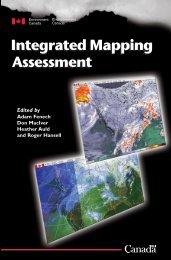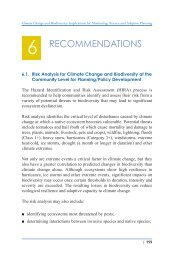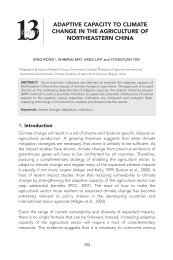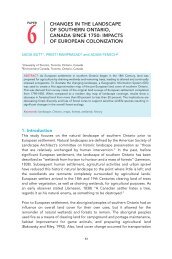Paper 3: Climate Change Adaptation for Neophytes - UPEI Projects
Paper 3: Climate Change Adaptation for Neophytes - UPEI Projects
Paper 3: Climate Change Adaptation for Neophytes - UPEI Projects
Create successful ePaper yourself
Turn your PDF publications into a flip-book with our unique Google optimized e-Paper software.
PAPER 3 CLIMATE CHANGE ADAPTATION FOR NEOPHYTESCategory 2 (Disciplines): Table 6.2 gives some indication of the comparativemakeup of the different disciplines within the field of climate changeadaptation 20 . There appears little question regarding the privileged position ofEconomics within the field given the number of articles identified as such (8.6%of the CCA dataset), but Political Science and Sociology are also wellrepresented with 7.5% and 4.1% of the total CCA articles respectively. Theremaining disciplinary distinctions include International Development, Ethics,and Communications & Education. The discipline of Psychology (0.4%) can beinterpreted in terms of the need to examine adaptation at the level of theindividual. Likewise, Anthropology (0.4%) provides a methodologicalperspective on local phenomena, and an awareness of how cultures and societieshave adapted in the past. Finally, the presence of Law seems self-evident giventhe many legal issues (i.e. international etc) involved in CCA.How these various disciplines fit together is not readily apparent until thePolitical Science literature is considered. One of the main tasks of this field is thedevelopment of appropriate CCA policies that can effectively integrate keyconsiderations (i.e. economic, sociological, ethical, etc.). A consequence of thispurpose is an apparent, ideal typic article <strong>for</strong>mat that adheres to the followingstructure: 1) political science articles generally start with a review of current, pastor proposed policy instruments (58% of Political Science articles); 2) then theydiscuss the implications or impacts of climate change <strong>for</strong> the a<strong>for</strong>ementionedpolicy within a given geo-politically referenced sector, resource, or value (35%);and finally 3) they project the impacts of proposed policy options (strategies)based upon the given criteria (35%). Critiqued and proposed policy options areconsidered in terms of integration (16%), mainstreaming (9%), sustainabledevelopment (7%) and/or goal orientation (5%).In this context, economics becomes an input in a process of climate changepolicy critique and <strong>for</strong>mation. This assumption seems borne out by the fact that23% of articles in the economics domain deal specifically with determining thefinancial impact of climate change. Other articles are also suggestive of thispolicy agenda: 9.5% of economics’ articles concern the measurement of goodsand services, 15.2% deal with risk and its avoidance, 13.3% examine thetemporal aspects associated with the longer time scales relevant to climate20 There is some discussion in the literature as to how different disciplines should relate to one another (Schneider,S. H. (1997). “Integrated assessment modeling of global climate change: Transparent rational tool <strong>for</strong> policy making oropaque screen hiding value-laden assumptions?” Environmental Modeling and Assessment 2(4): 229-249.), includingthe sciences themselves (Lorenzoni, I., M. Jones, et al. (2007). “<strong>Climate</strong> change, human genetics, and post-normality inthe UK.” Futures 39(1): 65-82).67










